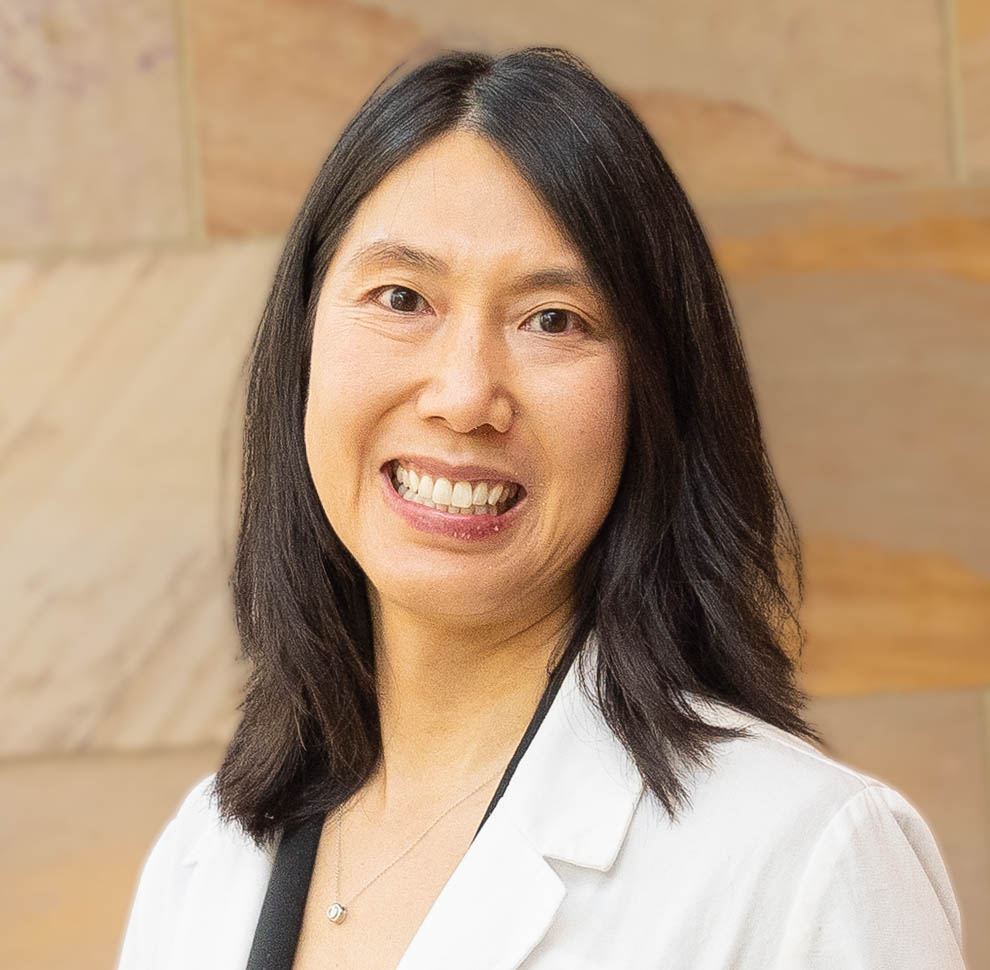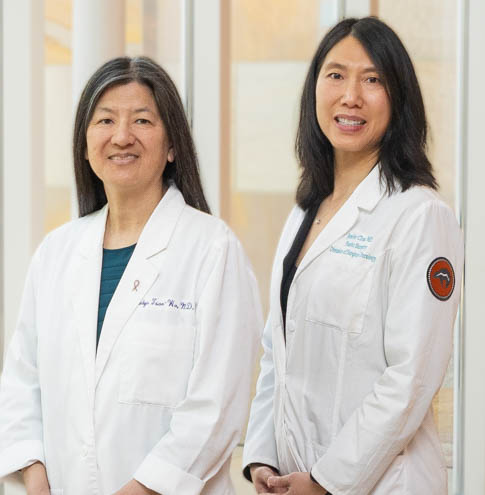For Gladys Tsao-Wu, MD, and Jennifer Chan, MD, reconstruction is as much about helping patients recover emotionally as it is about physical restoration.
For over a decade, the two surgeons have been a team, helping breast cancer survivors in New Mexico. Now, after years in private practice in Albuquerque, the duo has joined The University of New Mexico Comprehensive Cancer Center to help breast cancer survivors reclaim what the cancer took from them.
“Breast cancer impacts a lot of different parts of their lives. Restoring form and appearance helps with both physical and emotional healing,” said Tsao-Wu. “Their clothing fits better. They’re not having to fuss with a prosthetic or worry about it falling out. It helps people feel complete. Other types of cancer may not impact their physical appearance in the same way. For women, the breast can be a big part their femininity and identity.”
Joining the UNM Comprehensive Cancer Center offers a number of advantages, including being part of a team approach, where patients can access all of their cancer care needs under one roof.
“We’ve always had a great relationship with the physicians in the medical community, but there’s something nice about being able to talk with other physicians and providers in person as we share the same charting room. It facilitates communication,” said Chan. “And especially for the patients who come from out of town, being able to see all of their doctors at the same time streamlines their process.”
Tsao-Wu and Chan remain a team within the UNM Cancer Center’s breast team. This is due to their tandem approach to microsurgical reconstruction.
The process transfers a portion of tissue from the patient’s abdomen to the chest to reconstruct the breast. There are other surgeons in New Mexico who perform the procedure, but Chan and Tsao-Wu are the only ones who do it as a team.
The advantage to a two-surgeon team is that the procedure is shorter, increasing patient safety and decreasing patient recovery time.
Shorter recovery times and shorter surgical procedures can be important because breast reconstruction is not always accomplished in a single procedure. The entire reconstructive process may involve two or three operations spread out over six to 12 months, sometimes longer.

Breast cancer impacts a lot of different parts of their lives. Restoring form and appearance helps with both physical and emotional healing.
It is common that Tsao-Wu and Chan develop lifelong relationships with their patients.
“There is a subjective element to the outcome of the procedure,” Tsao-Wu said. “Do patients like how it turned out? Are they happy with how they look? Later, as patients age, their bodies change and they may come in for revisions to improve how the reconstruction fits their body.”
That can lead to follow-up procedures.
“In each of our cases, our job is to make the patient whole again and to feel comfortable about their appearance,” Chan said.
For some patients, these conversations can happen even before a cancer diagnosis.
“There’s also a population of patients who may not have diagnosed breast cancer but may have a genetic predisposition to it and choose to undergo a risk-reducing mastectomy,” Tsao-Wu said. “So not every patient we see is going through treatment.”
Plastic surgery has a very broad range of surgery types and problems it can address. When both Tsao-Wu and Chan came to Albuquerque, specializing in breast reconstruction wasn’t their expectation.
“When I came to Albuquerque, I discovered there was a huge need,” Chan said.
Tsao-Wu said the demand for breast reconstruction surgery eventually overwhelmed her private practice. The doctors joined forces to face the need and provide the full scope of reconstructive options to patients in New Mexico.
“What drew me to plastic surgery, and to surgery in general, was the act of trying to figure out what to do to solve a problem,” she said. “When I came into town there weren’t many surgeons doing breast reconstruction and no one was providing microsurgical breast reconstruction. We used to send patients out of state for that procedure. Over time, I had to eliminate other areas of plastic surgery from my practice to accommodate all the breast reconstruction patients.”
While demand may continue to be high, Tsao-Wu also said that it’s crucial for patients to get all the information they can before making such a complex decision.
“You should always explore all of your options,” she said. “Talk to your physicians and surgeons about what the options are. Sometimes you’re told significant information that may lead to a different set of options.”

About Gladys Tsao-Wu, MD
Gladys Tsao-Wu, MD, is an Assistant Professor in the UNM Department of Surgery, Division of Surgical Oncology. She holds a medical degree from Wake Forest University (1994). She completed her residency in general surgery (2001) and her fellowship in plastic surgery (2003) at Penn State University, Milton S. Hershey Medical Center.

About Jennifer Chan, MD
Jennifer Chan, MD, is an Assistant Professor in the UNM Department of Surgery, Division of Surgical Oncology. She holds a medical degree from St. Louis University (2002) and completed her residency in surgery at the UNM School of Medicine in 2007. She went on to complete her fellowship in plastic surgery at Tulane University School of Medicine in 2010.
UNM Comprehensive Cancer Center
The University of New Mexico Comprehensive Cancer Center is the Official Cancer Center of New Mexico and the only National Cancer Institute-designated Cancer Center in a 500-mile radius.
Its more than 136 board-certified oncology specialty physicians include cancer surgeons in every specialty (abdominal, thoracic, bone and soft tissue, neurosurgery, genitourinary, gynecology, and head and neck cancers), adult and pediatric hematologists/medical oncologists, gynecologic oncologists, and radiation oncologists. They, along with more than 600 other cancer healthcare professionals (nurses, pharmacists, nutritionists, navigators, psychologists and social workers), provide treatment to 65% of New Mexico’s cancer patients from all across the state and partner with community health systems statewide to provide cancer care closer to home. They treated almost 15,000 patients in more than 100,000 ambulatory clinic visits in addition to in-patient hospitalizations at UNM Hospital.
A total of nearly 1,855 patients participated in cancer clinical trials testing new cancer treatments that include tests of novel cancer prevention strategies and cancer genome sequencing.
The more than 123 cancer research scientists affiliated with the UNMCCC were awarded $38.2 million in federal and private grants and contracts for cancer research projects. Since 2015, they have published nearly 1000 manuscripts, and promoting economic development, they filed 136 new patents and launched 10 new biotechnology start-up companies.
Finally, the physicians, scientists and staff have provided education and training experiences to more than 500 high school, undergraduate, graduate, and postdoctoral fellowship students in cancer research and cancer health care delivery.
